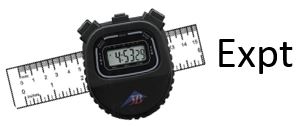PHY385 Module 9: Dispersion in Dielectrics
Table of contents
 Activity 9.1 – Radiation Pressure & Momentum - Index of Reflection
Activity 9.1 – Radiation Pressure & Momentum - Index of Reflection
For this Activity, you need to know the definition of the index of reflection and the properties of a photon. The index of reflection of a surface is given by R = ureflected/ uincident and shows the fraction of the incident energy being reflected by the surface. The photon energy is E = fh; and the photon momentum is p = E / c, where c is the speed of light in free space.
- Find the total linear momentum transferred to the completely absorbing screen that receives 300 W of light for 100 s.
- What is the momentum of a 1019 - Hz X-ray photon?
This activity was created by Natalia Krasnopolskaia in October 2014.
 Activity 9.2 – Dispersion in Dielectrics
Activity 9.2 – Dispersion in Dielectrics
The dispersion is a phenomenon of dependence of the index of refraction of the monochromatic wave (or the phase speed of propagation of the wave) in a substance on the wavelength.
The textbook suggests a linear function for the relationship between the refractive index of a medium and the wavelength (Ch. 3, page 72):
The figure below shows a diagram for estimated behaviour of the function n(λ) for liquids and solids.

Assume that air has n = 1. With water and glycerine samples prove either of the above relationships.
For the experiment you will use the following equipment:
-
three plastic cups with a washer at the bottom;
-
a vessel with tap water;
-
a vessel with glycerine;
-
a ruler;
-
a set of filters transparent for different wavelengths: 436 nm, 520 nm and 675 nm; and
-
tissues for keeping your workplace, equipment and your hands dry and clean.
Place two empty cups close to each other and look at the washer from the top positioning your eye closer to the top of the cup. With the ruler outside the cup define the distance from your eye to the washer and record the value. If all lab partners perform this measurement in turn, the average value will account for the random uncertainty.
9.2.1. Experiment with water.
- Tme all steps of the experiment with water to know whether you will have time to repeat measurements with glycerine.
- Fill one of the cups with water to the top. The deeper the liquid, the more accurate measurements are expected. However, you should be careful working with liquids in such unstable vessels!
- Look at the washer normally to the water surface positioning your eye close to the water surface. With the ruler outside the cup, measure the distance to the image of the washer and record this measurement.
- The index of refraction of white light in water is about 1.3333. Using your measurements, compare the experiment result with the expected value of 1.3333 and give a difference in percents.
- Repeat the experiment with at least three filters: blue, green and red. Calculate the index of refraction of specific wavelengths in water. It is recommended that you save 5 significant figures in the value of n. Plot the results of measurements either as "n vs. λ" or as "(n2 -1)-1 vs. λ-2 "
- Conclude on the dispersion relation of the refractive index in water.
- Put the cup with water aside, far from your workplace.
9.2.1. Experiment with glycerine.
- Use the third cup with a washer to perform all steps explained above with the glycerine 99%-solution. The expected value for white light is 1.4723.
- Fill the cup with glycerine almost to the top. The deeper the liquid, the more accurate measurements are expected. However, you should be careful working with liquids in such unstable vessels!
- Put the cup with glycerine on the lab table far from your workplace and clean the table you are working at.
- Conclude on the accuracy of the results for the used substance(s) and the sources of uncertainty.
This activity was created by Natalia Krasnopolskaia in October 2014.














